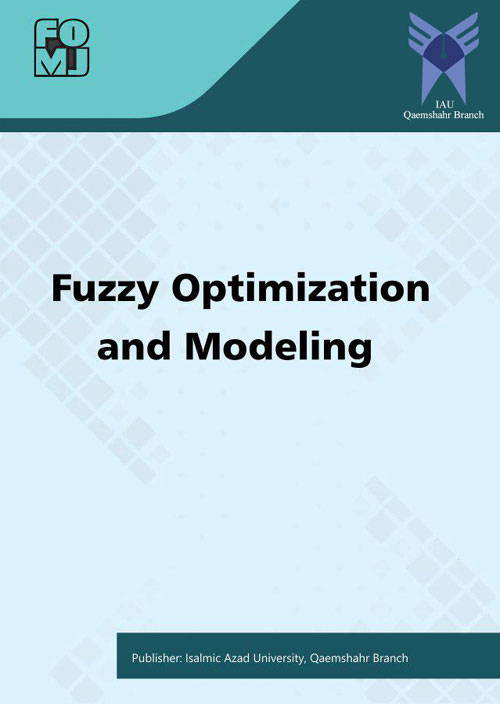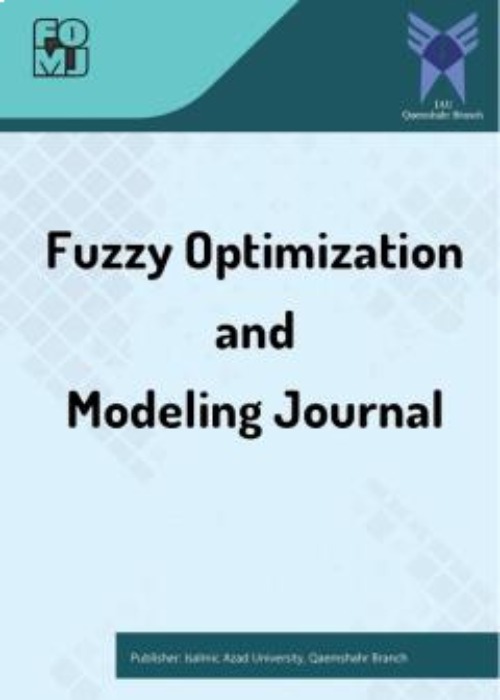فهرست مطالب

Fuzzy Optimzation and Modeling
Volume:2 Issue: 1, Winter 2021
- تاریخ انتشار: 1400/03/24
- تعداد عناوین: 6
-
Pages 1-11To the best of our knowledge, there is only two approaches for constructing an intuitionistic fuzzy linear regression model (regression model in which all the variables and coefficients are considered as intuitionistic triangular fuzzy numbers). However, after a deep study, some mathematical incorrect assumptions have been considered in these approaches. Therefore, it is scientifically incorrect to use these approaches for general real-life data. Keeping the same in mind, in this paper, a new approach (named as Ishita approach) is proposed to construct an intuitionistic fuzzy linear regression model. The proposed approach overcomes the limitations of the existing approaches. It is fit for positive, negative or mixed of positive and negative datasets represented as symmetric or asymmetric intuitionistic triangular fuzzy numbers. Moreover, the constructed models of the proposed approach guarantee the homogeneity principle such that for symmetric intuitionistic fuzzy data, the constructed model is symmetric, i.e., the estimated model’s coefficients are symmetric intuitionistic fuzzy numbers. Furthermore, the proposed approach is illustrated with the help of a numerical example.Keywords: Atanassov’s triangular intuitionistic fuzzy number (ATIFN), Intuitionistic fuzzy linear regression, Least absolute deviations
-
Pages 12-21In this article, first the aggregation operator and the operational waves in the oscillators are introduced. Next, we choose a demanded Electrical waveform in the demanded oscillator using a model have been done. We use the fuzzy soft aggregation operator in the oscillators on L2 space at the method can be successfully applied to many problems that contain uncertainties. Our simulation is done with R software.Keywords: Aggregation operator, fuzzy set, Fuzzy soft set
-
Pages 22-36Data Envelopment Analysis (DEA) is a widely used technique for measuring the relative efficiencies of Decision Making Units (DMUs) with multiple inputs and multiple outputs. However, Undesirable Outputs (UO) may be present in the production process which needs to be minimized. In real-world problems, the observed values of the input and output data are often vague or random. Indeed, Decision Makers (DMs) may encounter a hybrid uncertain environment where fuzziness and randomness coexist in a problem. This paper proposes fuzzy stochastic DEA model with undesirable outputs. The extensions to the fuzzy-stochastic environment sometimes may be laid to disregard some of the properties in DEA models such as linearity and feasibility. In this way, we apply a new version of DEA-UO model according to the probability-possibility approach to propose a linear and feasible model in deterministic form. A numerical example is presented to illustrate the features and the applicability of the proposed models.Keywords: Data envelopment analysis, Undesirable output, Fuzzy random variable, Possibility–probability
-
Pages 37-41The truth of the false extraction method of digital control system is developed in the false reality to overcome the challenge and continue to design controllers for real systems. However, the scheme to control the false extraction of real system is complex, so it is not suitable for use in practice. In order to verify the asymptotic state with a false reality can be considered by discrete systems, this article calculates a neural neural network (NN) controller with a mean bat algorithm. This view of this evolved fuzzy NN control is performed using the domain of false reality can be considered from model to model transformation polylinear linear rule of thumb, and the new measures on asymptotic stability. Simulation results show that the proposed method can make the system asymptotically stable in discrete time. The dual model of strength and EBA also provides flexibility and efficiency in finding solutions for managed systems.Keywords: Evolved control, Nonlinear systems, Neural network
-
Pages 42-49Selecting optimal facility location is a challenging decision, as it is expensive to relocate the facilities once they are located. The aim of this paper is to find optimal location of schools in pastoral communities in Mille Woreda, Afar region, Ethiopia. In this study, Fuzzy AHP approach is used to prioritize the candidate locations with respect to environmental (vegetation & proximity to water source), social (distance between facility and demand points & exposure conflict), and geological (history of natural disaster & suitability of location) factors. For obtaining the comparison matrix of the criteria’s and alternatives, questionnaire was designed and filled by the decision makers (academicians and officials from education bureau). From the candidate locations Alidewarto & Wekki were found to be optimal locations for locating new schools. This will help to ensure the education for all program of the government by providing a framework for locating schools in pastoral communities..Keywords: Fuzzy-AHP, Optimal Location, Pastoral communities
-
Pages 50-59
In this paper, we investigate the existence and uniqueness of solution for fractionalboundary value problem (FBVP) with the integral boundary conditions. We use the contraction mapping principle and Krasnoselskii’s fixed point theorem to obtain some new existence and uniqueness results.
Keywords: Atangana-Baleanu fractional derivative, Fractional boundary value problem, Integral boundary conditions, Fixed point theory


